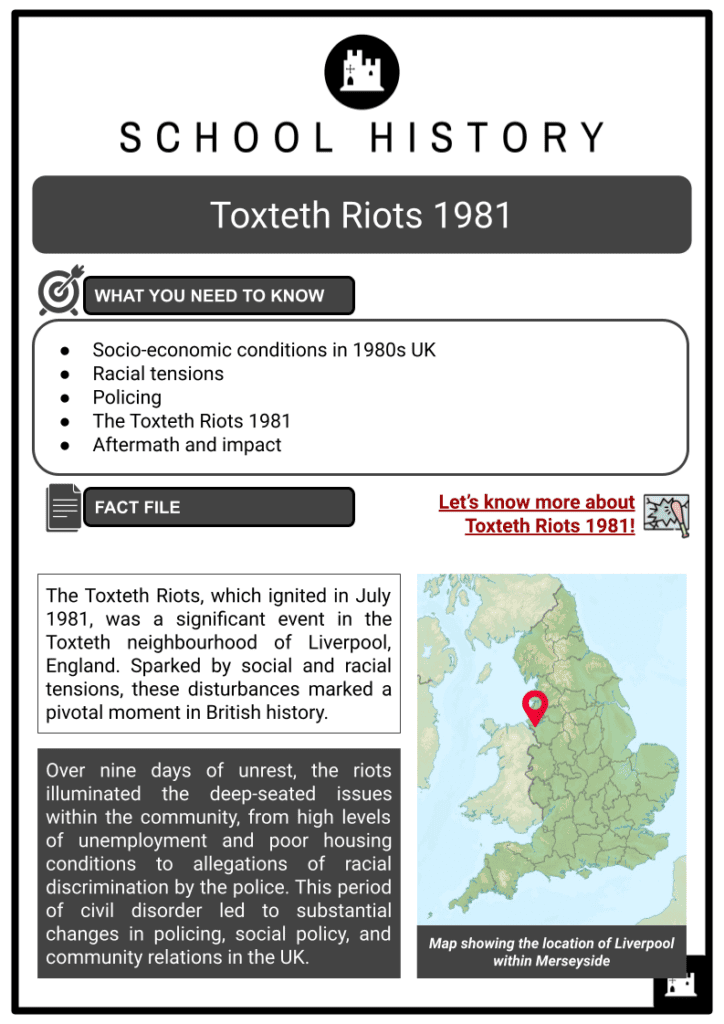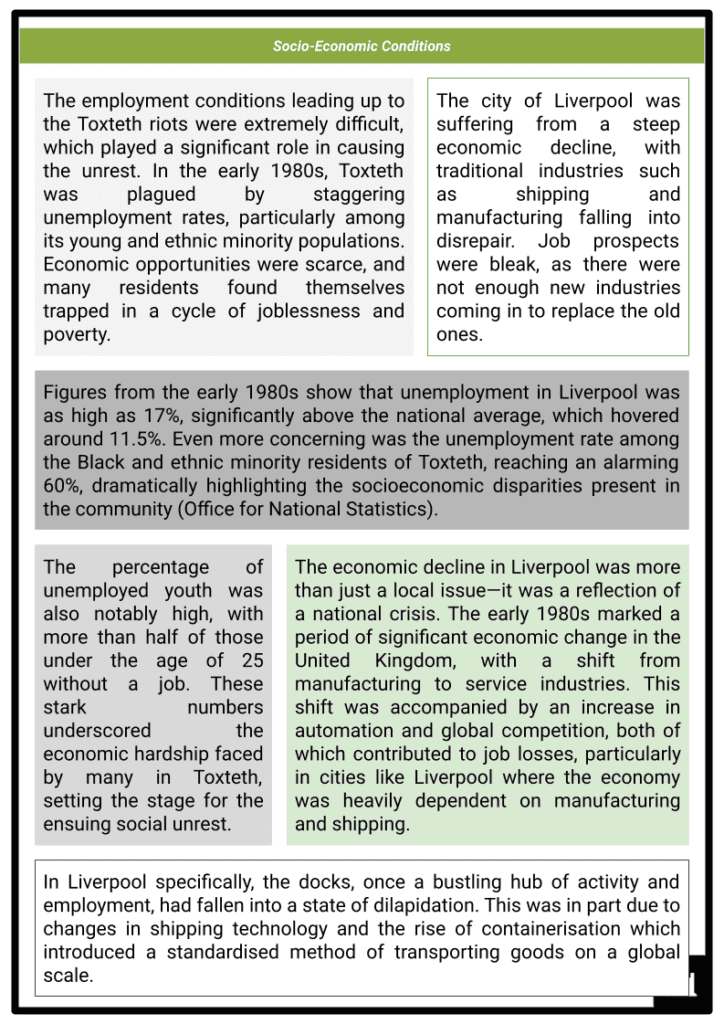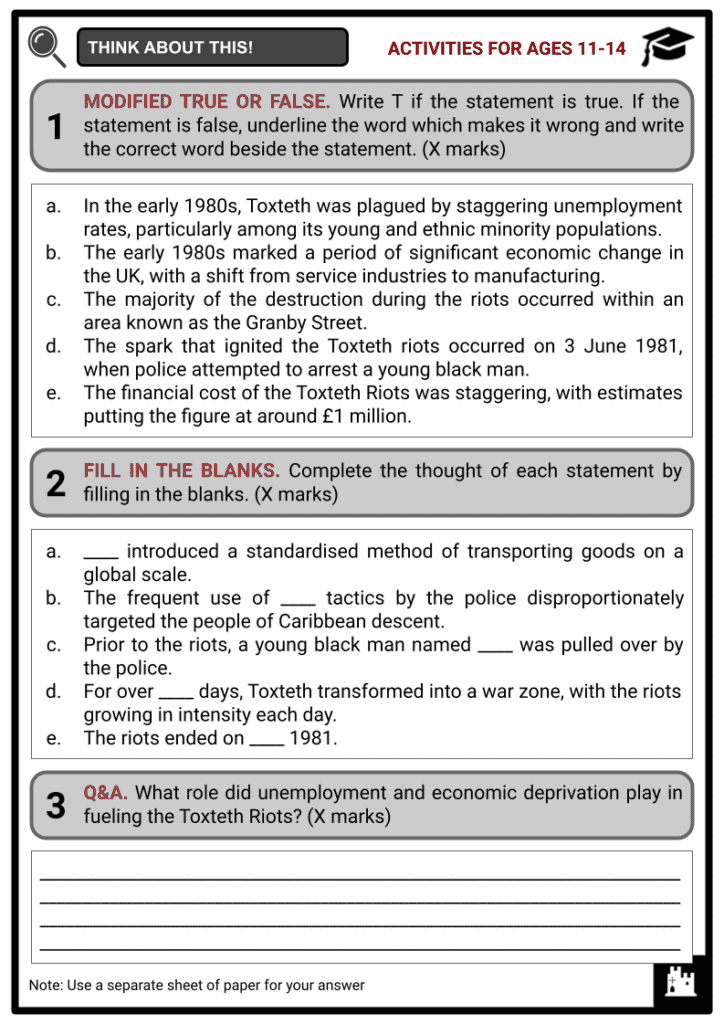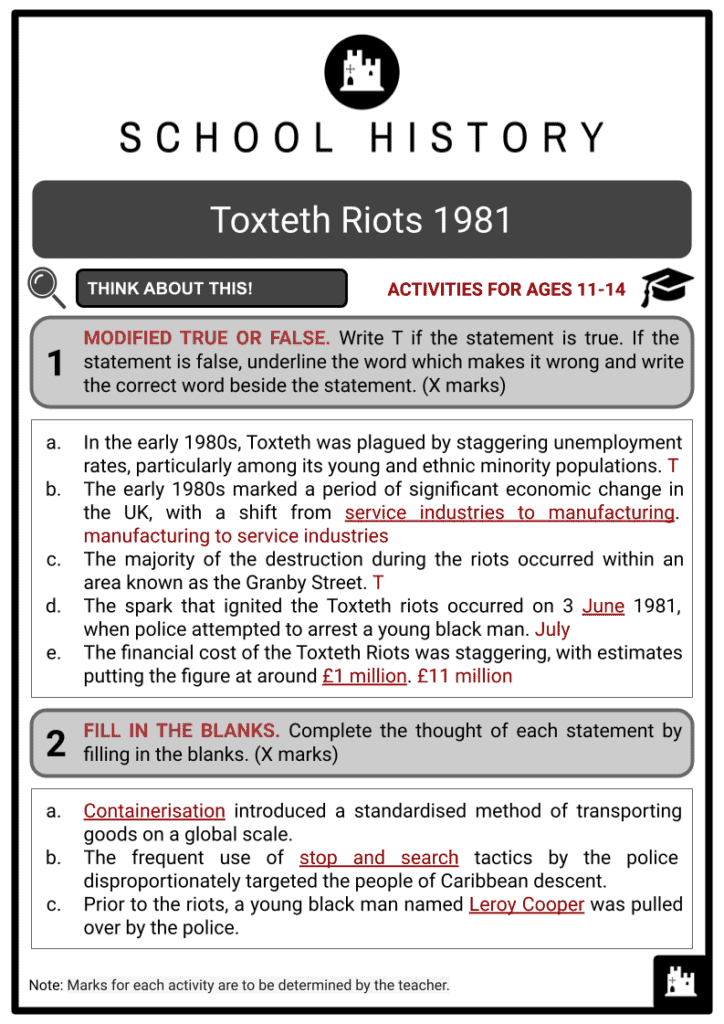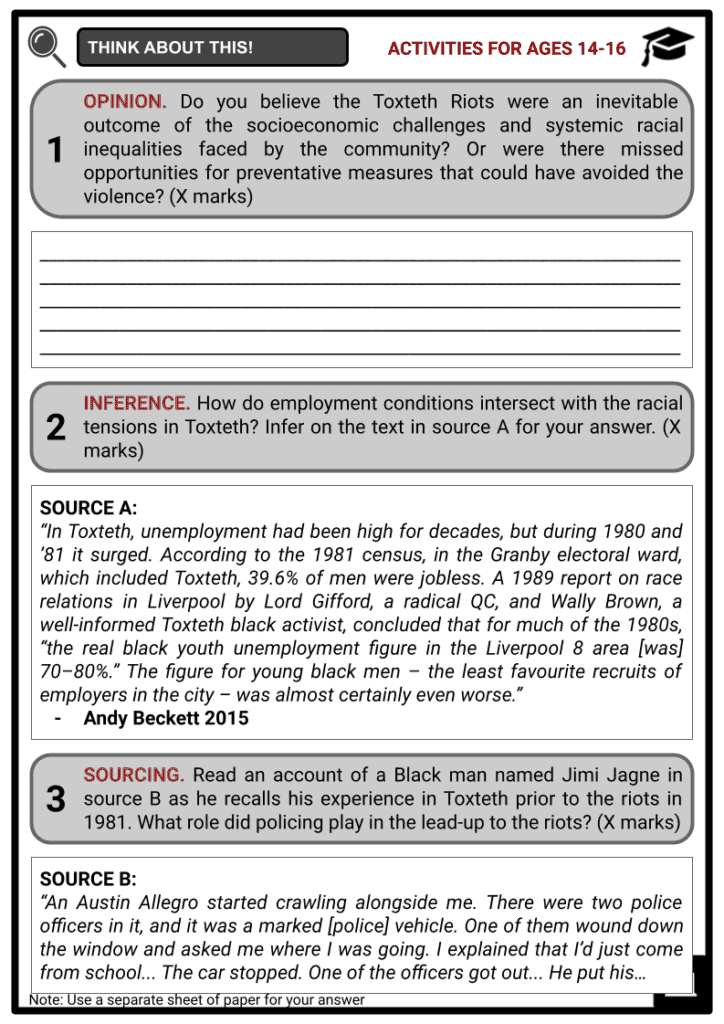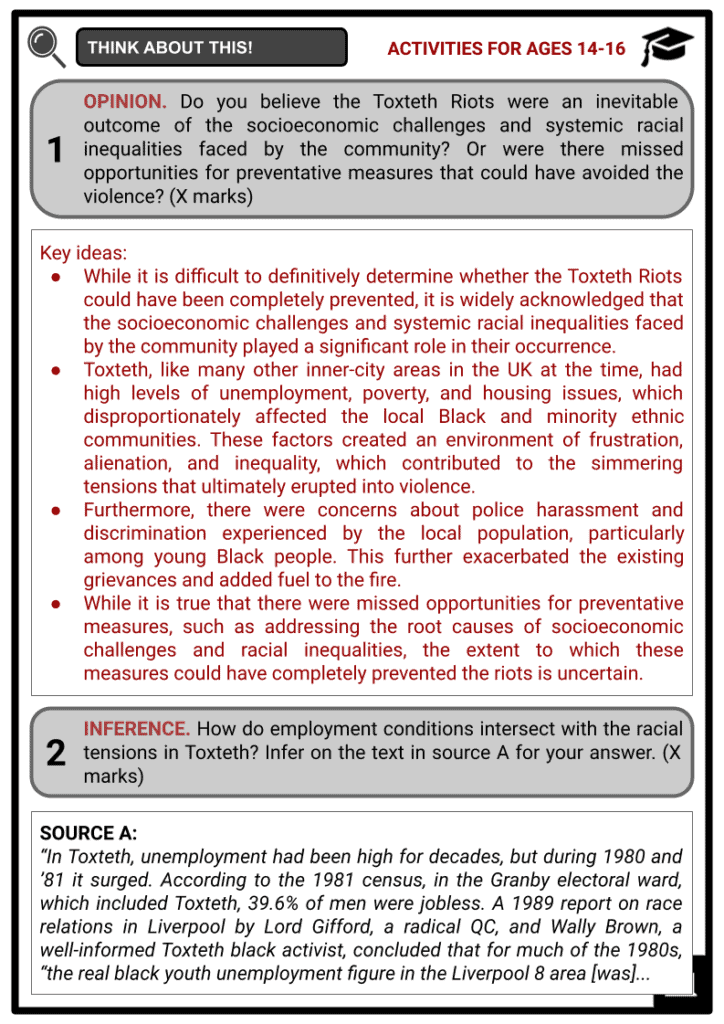Toxteth Riots 1981 Worksheets
Do you want to save dozens of hours in time? Get your evenings and weekends back? Be able to teach about the Toxteth Riots 1981 to your students?
Our worksheet bundle includes a fact file and printable worksheets and student activities. Perfect for both the classroom and homeschooling!
Summary
- Socio-economic conditions in 1980s UK
- Racial tensions
- Policing
- The Toxteth Riots 1981
- Aftermath and impact
Key Facts And Information
Let’s know more about Toxteth Riots 1981!
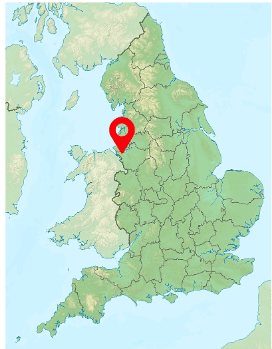
The Toxteth Riots, which ignited in July 1981, was a significant event in the Toxteth neighbourhood of Liverpool, England. Sparked by social and racial tensions, these disturbances marked a pivotal moment in British history. Over nine days of unrest, the riots illuminated the deep-seated issues within the community, from high levels of unemployment and poor housing conditions to allegations of racial discrimination by the police. This period of civil disorder led to substantial changes in policing, social policy, and community relations in the UK.
Socio-Economic Conditions
- The employment conditions leading up to the Toxteth riots were extremely difficult, which played a significant role in causing the unrest. In the early 1980s, Toxteth was plagued by staggering unemployment rates, particularly among its young and ethnic minority populations. Economic opportunities were scarce, and many residents found themselves trapped in a cycle of joblessness and poverty.
- The city of Liverpool was suffering from a steep economic decline, with traditional industries such as shipping and manufacturing falling into disrepair. Job prospects were bleak, as there were not enough new industries coming in to replace the old ones.
- Figures from the early 1980s show that unemployment in Liverpool was as high as 17%, significantly above the national average, which hovered around 11.5%. Even more concerning was the unemployment rate among the Black and ethnic minority residents of Toxteth, reaching an alarming 60%, dramatically highlighting the socioeconomic disparities present in the community (Office for National Statistics).
- The percentage of unemployed youth was also notably high, with more than half of those under the age of 25 without a job. These stark numbers underscored the economic hardship faced by many in Toxteth, setting the stage for the ensuing social unrest.
- The economic decline in Liverpool was more than just a local issue—it was a reflection of a national crisis. The early 1980s marked a period of significant economic change in the United Kingdom, with a shift from manufacturing to service industries. This shift was accompanied by an increase in automation and global competition, both of which contributed to job losses, particularly in cities like Liverpool, where the economy was heavily dependent on manufacturing and shipping.
- In Liverpool specifically, the docks, once a bustling hub of activity and employment, had fallen into a state of dilapidation. This was in part due to changes in shipping technology and the rise of containerisation, which introduced a standardised method of transporting goods on a global scale.
- The new system of containerisation involved packing goods into large, uniform containers, which could be easily loaded, unloaded, and transferred from ships to trucks or trains. The process dramatically improved efficiency, reduced shipping times and lowered costs. However, it also had significant implications for traditional port cities like Liverpool.
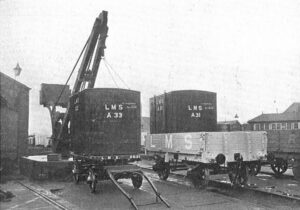
Transferring freight containers - The shift to containerisation necessitated newer and more sophisticated dock facilities that could accommodate these large containers. Many of the old docks, including those in Liverpool, could not support this new technology, rendering them obsolete. This expedited the economic decline of Liverpool's docks, further exacerbating the city's unemployment and economic woes.
- The impact was particularly severe in the Toxteth area, where unemployment and poverty levels were already high. The sense of hopelessness among the young population was palpable. Many felt ignored and neglected by the government, and frustration was mounting. The lack of job opportunities not only affected the youth's economic status but also their self-esteem and aspirations, creating a fertile ground for social unrest.
- The government's neglect was visible not only in the lack of adequate response to the job crisis but also in the insufficient investment in local infrastructure and social services. Educational institutions were underfunded, leading to graduates being ill-prepared for the changing job market.
- Public housing was in disrepair, with residents often living in squalid conditions. Basic amenities such as healthcare and public transportation were either under-resourced or completely absent, further isolating Toxteth from the rest of Liverpool. Despite frequent appeals and protests, the government failed to provide any meaningful solutions, deepening the sense of abandonment felt by the people of Toxteth.
Racial Tensions
- The socio-economic desperation was further aggravated by the racial tensions of the time. Many inhabitants of Toxteth, a majority of whom were of Caribbean descent, felt excluded and marginalised by a society they viewed as predominantly white and indifferent to their struggles.
- Residents of Caribbean descent felt a palpable sense of discrimination, which was not only confined to the labour market but also manifested itself in their daily lives. Experiences of racial profiling and heavy-handed police tactics were not uncommon, exacerbating the sense of alienation and marginalisation.
- These collective experiences of racial prejudice served to further entrench feelings of disenfranchisement, adding to the prevailing discontent. Such racial tension was not an isolated phenomenon but rather interwoven with the socio-economic issues prevalent in Toxteth. It was a fuel that ignited the fire of frustration, eventually leading to the notorious riots that shook the community and the country at large.
Policing
- The policing methods during this period further instigated and intensified the hostilities. There was a palpable perception among the residents of Toxteth that the police force, rather than acting as protectors, was imposing an unjust and discriminatory system.
- Their frequent use of 'stop and search' tactics, often without any legitimate cause, disproportionately targeted the people of Caribbean descent.
- This policing practice was seen as an explicit manifestation of racial prejudice, breeding an ingrained mistrust towards law enforcement among the community members.
- The visible absence of diversity within the police force only reinforced the perception of an 'us versus them' dynamic. Consequently, the relationship between Toxteth residents and the police was marked by tension and conflict, setting the stage for the subsequent civil unrest.
- The spark that ignited the Toxteth riots occurred on 3 July 1981, when police attempted to arrest a young Black man. In the early evening hours, a young Black man named Leroy Cooper was pulled over by the police for what they claimed was a 'routine' traffic stop.
- However, the residents of Toxteth saw it differently. They saw a community member being singled out without justifiable cause, a familiar sight that had become a symbol of the pervasive institutional racism they had long endured.
- The police's 'routine' traffic stop was now perceived as another act of racial profiling, reinforcing feelings of mistrust and resentment towards law enforcement. The police's handling of the escalating situation was excessively forceful, intensifying the existing discontent. The altercation drew a crowd who passionately protested against the perceived police harassment, turning a routine traffic stop into a volatile situation.
The Riots
- The confrontation quickly escalated as word of the arrest spread, resulting in an outpouring of long-simmering frustration and anger. Residents began to retaliate, attacking police officers with bricks, bottles, and petrol bombs. The situation spiralled out of control, with the police initially outnumbered and struggling to restore order.
- Over the next nine days, Toxteth transformed into a war zone, with the riots growing in intensity each day. Stores were looted, cars were set aflame, and buildings were reduced to rubble. The majority of the destruction during the riots occurred within an area known as the Granby Street.
- It was estimated that approximately 500 police officers were injured. In response, the police made around 500 arrests, largely of young men from the local community.
- According to reports, the extensive property damage included around 70 buildings that were razed to the ground and approximately 100 cars that were set on fire. The financial cost of the riots was staggering, with estimates putting the figure at around £11 million, a sum equivalent to over £40 million in today's terms when adjusted for inflation (Office for National Statistics).
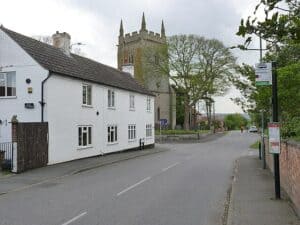
Granby main street - Despite the intensity of the riots, miraculously, only one fatality was recorded - a disabled man who tragically died when his flat was set alight during the disturbances. The violence and destruction were a stark, tangible manifestation of the community's deep-seated resentment towards what they perceived as years of neglect and racial discrimination. The riots finally ended on 12 July 1981, leaving Toxteth scarred and its residents facing an uncertain future.
Aftermath and Impact
- The aftermath of the Toxteth riots was marked by a profound shift in both public policy and societal attitudes. The physical devastation that had been wrought upon the community served as a stark illustration of the deep-seated societal issues that had prompted the riots. This led to a significant reconsideration of how the government dealt with issues of social inequality, racial discrimination, and urban decay.
- Prime Minister Margaret Thatcher, responding to the severity of the situation, initiated the establishment of the 'Merseyside Task Force' - a governmental body charged with the task of rebuilding the devastated area and improving its socio-economic conditions.
- The task force's efforts resulted in significant urban regeneration, with millions of pounds invested in housing, employment schemes, and amenities. Schools were modernised, and local businesses received government support to recover and grow.
- However, despite these efforts, the impact of the riots on the local community was long-lasting. The immediate aftermath saw a surge in unemployment rates and an exodus of businesses and middle-class residents, leading to a further deterioration of the local economy. The social fabric of the community was adversely affected, with increased crime rates and deep mistrust between residents and the police.
- In the decades following the riots, the area has undergone substantial physical and socio-economic transformation. Nonetheless, the memory of 1981 continues to cast a long shadow, serving as a sobering reminder of the consequences of neglect and discrimination. The Toxteth riots ignited a shift in policy and attitude, yet the struggle for true equity and social justice continues.
Image Sources
- https://upload.wikimedia.org/wikipedia/commons/thumb/5/52/England_relief_location_map.jpg/800px-England_relief_location_map.jpg
- https://upload.wikimedia.org/wikipedia/commons/f/f6/LMS_freight_containers_on_lorry_and_rail_wagon_%28CJ_Allen%2C_Steel_Highway%2C_1928%29.jpg
- https://upload.wikimedia.org/wikipedia/commons/thumb/2/29/Main_Street%2C_Granby_-_geograph.org.uk_-_3955986.jpg/640px-Main_Street%2C_Granby_-_geograph.org.uk_-_3955986.jpg
Frequently Asked Questions
- What were the Toxteth Riots in 1981?
The Toxteth Riots, which occurred in July 1981, were a series of disturbances and protests in the Toxteth area of Liverpool, England. The riots were part of a broader wave of civil unrest across many UK cities during that period.
- What were the main causes of the Toxteth Riots?
A complex interplay of socioeconomic factors, including high unemployment rates, racial tensions, police harassment, and a sense of marginalisation among the local communities, fueled the Toxteth Riots. Deep-seated economic inequalities and institutional racism also contributed to the unrest.
- How many people were injured or arrested during the Toxteth Riots?
Hundreds of people, both civilians and police officers, were injured during the riots. Additionally, many arrests were made, with estimates ranging from hundreds to over a thousand individuals detained.

